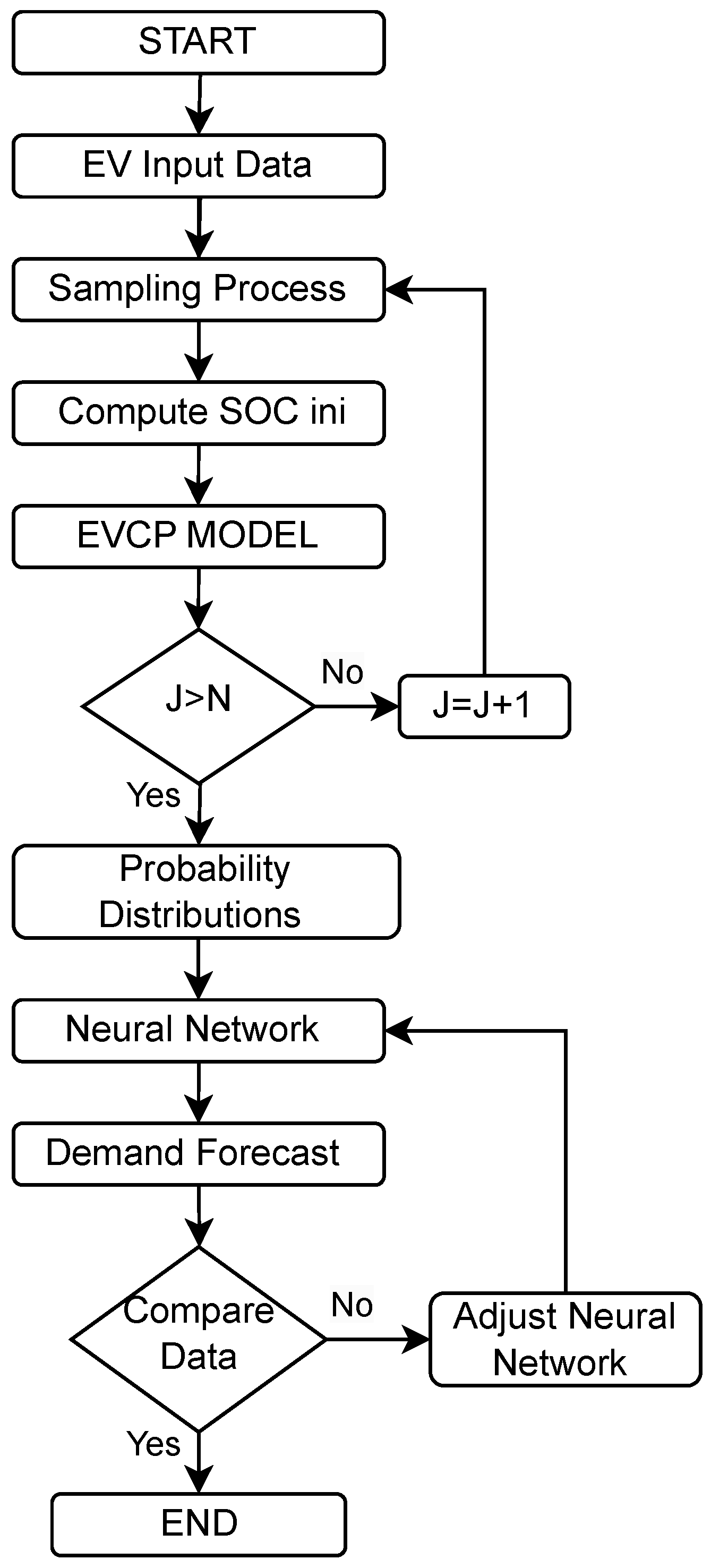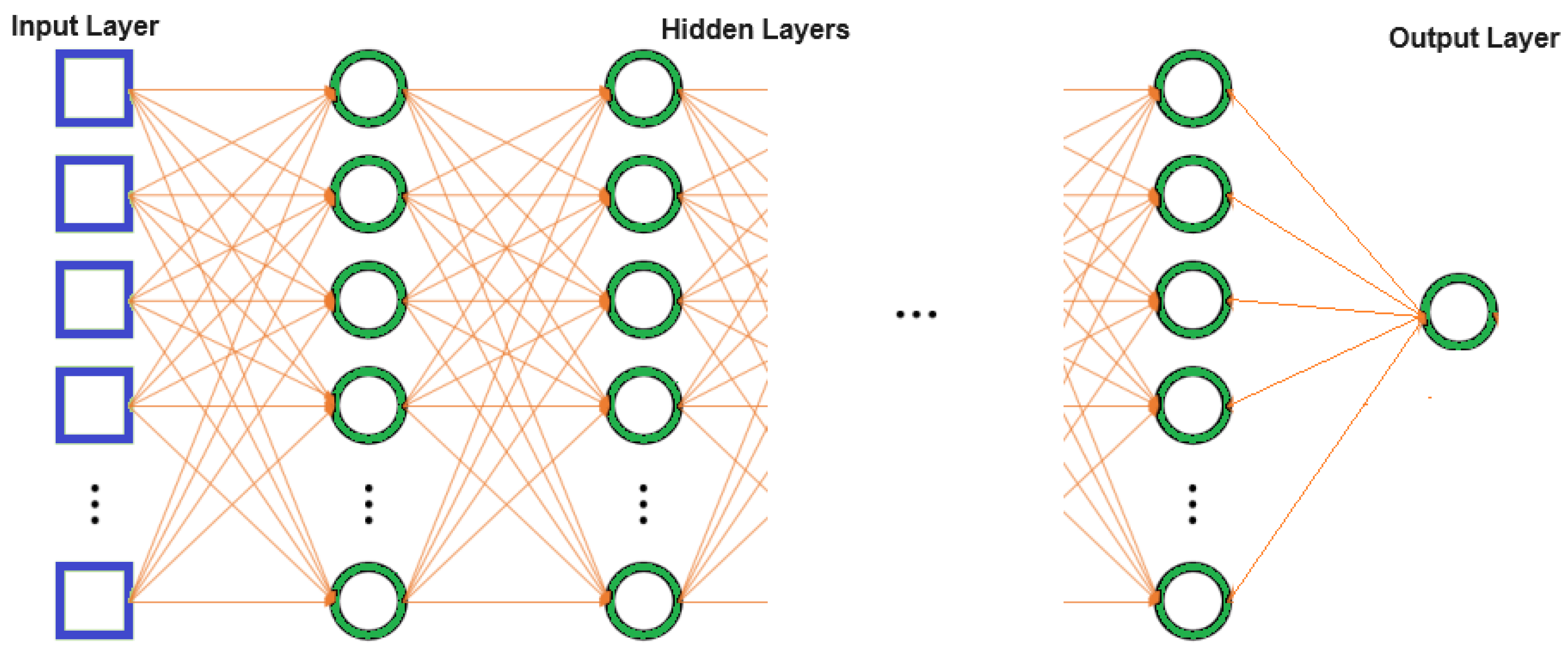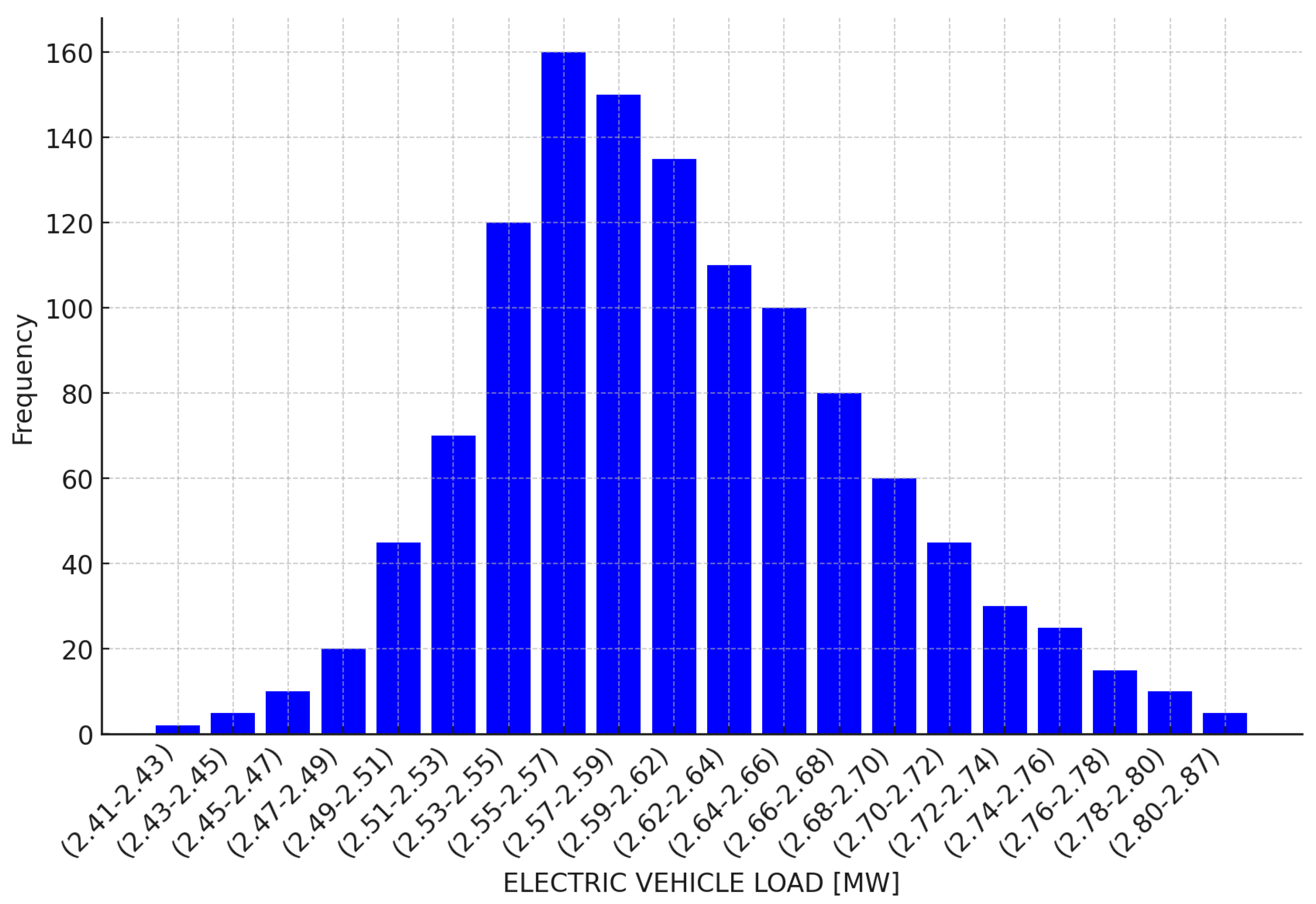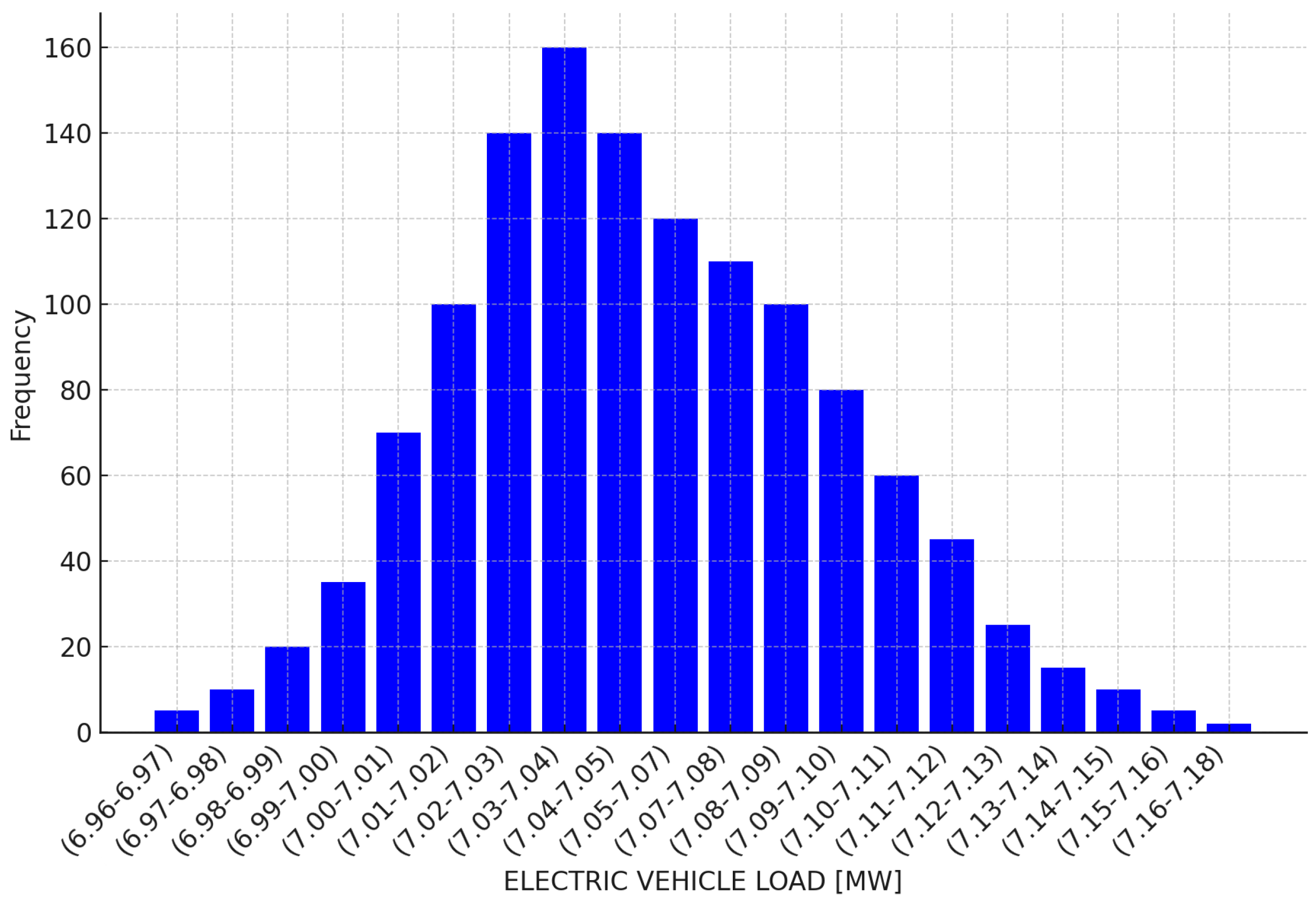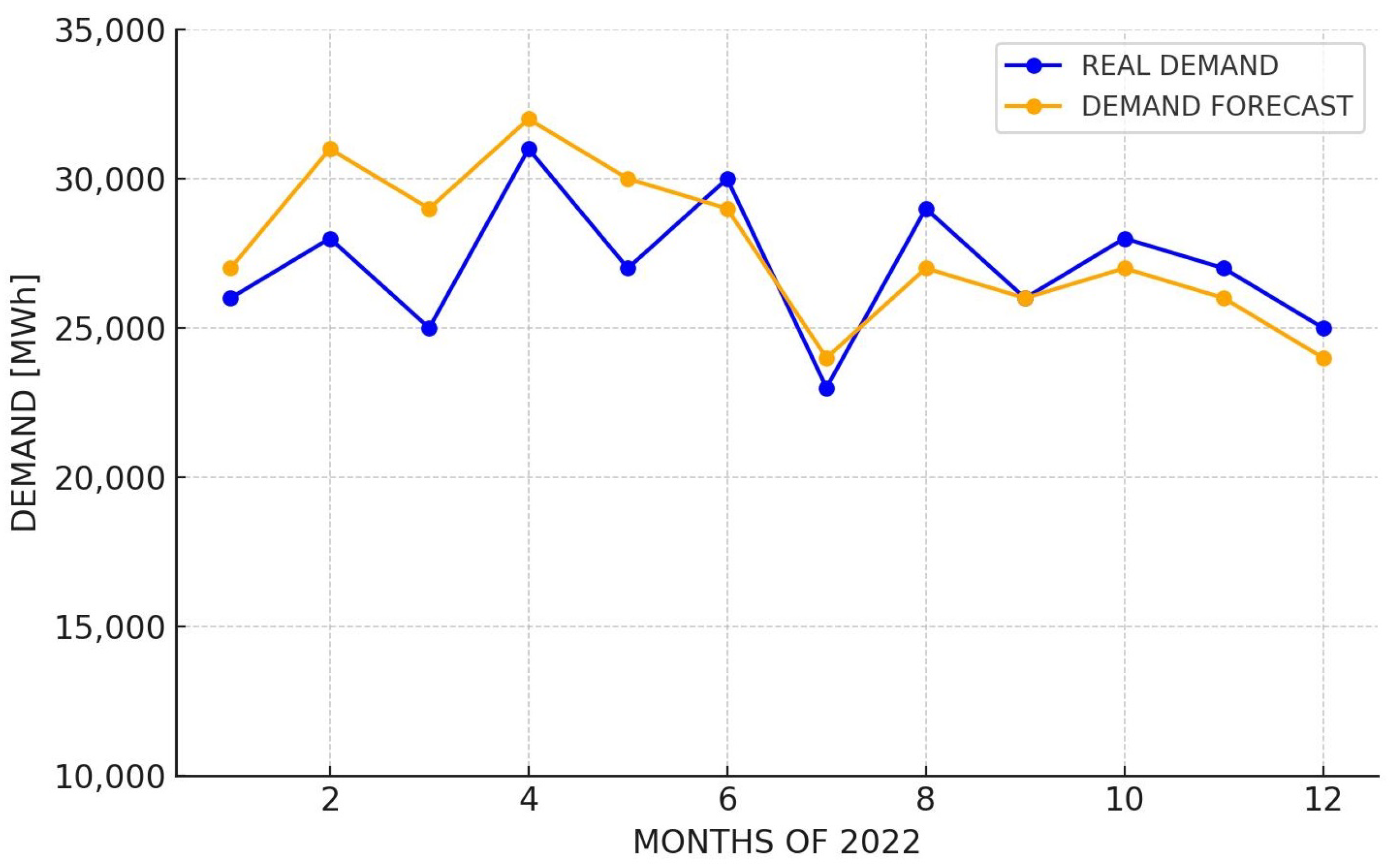1.1. Motivation
The integration of electric vehicles (EVs) into the power grid is a crucial strategy for addressing global warming and enhancing the efficiency of the power system. By reducing dependence on fossil fuels, EVs can significantly lower greenhouse gas emissions. Additionally, their adoption supports cleaner and more sustainable energy consumption [
1]. However, this transition comes with its own set of challenges. For the successful and sustainable implementation of EVs, it is essential to address issues such as developing adequate charging infrastructure, advancing battery technology, and integrating renewable energy sources into the grid [
2].
In this context, one challenge is the increased electricity consumption resulting from the introduction of EVs into the grid [
3]. Charging these vehicles adds additional demand to the electricity system, which can have significant implications, particularly during peak demand periods. Moreover, the variability in EV charging—depending on when, where, and at what speed the vehicles are charged—can cause fluctuations in the electrical load and affect grid stability [
4].
The impacts of the introduction of EVs extend beyond the energy sector. Effects have been identified in industries such as transportation, manufacturing, and the economy, in general. These impacts can be related to changes in energy demand, charging infrastructure, EV supply chain, and job creation. For example, in [
5], the authors present an assessment of the technical impacts of EV penetration in distribution networks. To address the issues arising from the mass adoption of EVs, it is essential to implement strategies for their intelligent management [
6]. This involves the efficient coordination of charging, considering factors such as usage patterns, the availability of renewable energy, and the capacity of the electrical grid. The implementation of smart charging technologies, along with policies that encourage off-peak charging, can help mitigate the negative impacts on the electrical grid [
7].
Additionally, the careful planning of charging infrastructure, the promotion of electric mobility in specific areas, and the integration of renewable energy are crucial aspects to maximize the benefits of EVs and minimize their adverse impacts. In summary, the transition to electric vehicles requires a comprehensive approach that addresses the energy challenges and the economic and social aspects associated with this transformation [
1].
The aforementioned aspects require the development of more accurate EV charging models to better assess their impact on the electrical grid. Various approaches have been proposed to model EV charging [
8]. These include deterministic techniques for EV charging modeling [
9], Monte Carlo simulation (MCS) approaches [
10], fuzzy methods [
11], hybrid Fuzzy-MCS methods [
12], linear programming approaches [
13], and other techniques [
14,
15]. Accurate EV charging models can also significantly impact the demand forecasts of electrical grids.
Integrating demand forecasts with accurate EV charging models is essential for managing the challenges of EV introduction to the electrical grid. This approach enables the adjustment of EV charging strategies based on energy demand variations, optimizing infrastructure use and preventing congestion. Analyzing demand forecasts helps identify daily, weekly, and seasonal energy patterns [
16]. It is essential to assess the impact of EVs on demand, understanding how their charging coincides with or differs from periods of high forecast demand and whether there are correlations between energy demand and charging patterns.
Using forecasts to model scenarios with higher EV penetration helps anticipate impacts on grid capacity and efficiency, enabling better infrastructure planning and smart charging strategies. Integrating demand forecasts with EV charging models provides a detailed view of future energy demand, facilitating effective planning and strategies for sustainable electric mobility. Furthermore, to the best of our knowledge, there are no existing studies in the technical literature that provide demand forecasts specifically for the city of Medellin, considering the factors addressed in this paper.
1.2. Literature Review
Several approaches have been suggested to model electric vehicle (EV) charging, which can be categorized into three main groups: deterministic, data-driven, and uncertainty/variability models, as outlined by [
6].
In deterministic models, EV parameters like arrival and departure times, available charging period, and travel distance are predefined by the grid operator, treating EVs as stationary energy storage systems [
8]. Other studies use measurement-based approaches to model EV fast-charging stations by minimizing the difference between real load measurements and simulated loads, as seen in [
17]. A modified backward–forward sweep method was implemented in [
9] to assess the impact of EV charging models on the grid using constant current and voltage-dependent loads. These deterministic models are also referred to as traditional methods.
Data-driven models, on the other hand, use large datasets to capture EV charging patterns more accurately than deterministic approaches, which struggle with real-time driving data [
3]. These models rely on historical data to reflect driver behavior, which affects EV energy consumption. Data mining techniques like clustering, correlation analysis, and time series clustering are commonly applied to analyze driving data [
8,
18]. For example, time series clustering was used to analyze hybrid EV driving cycles in [
18], while [
3] applied a two-level clustering model to identify driving patterns that influence the daily load curve. These data-driven methods offer flexibility and scalability but can perform poorly with low-dimensional real-time data.
Several data-driven approaches have been suggested to characterize EV charging behaviors and analyze driving data. Techniques like clustering [
8], correlation analysis [
19], stochastic prediction [
20], and time series clustering [
18] are commonly used. For instance, ref. [
18] developed a time series clustering method with variable weights to study hybrid EV driving cycles. The authors in [
8] utilized historical residential charging data to create probability density functions for modeling charging durations and applied k-nearest neighbors clustering for decision-making. The authors in [
3] proposed a two-level clustering model to identify EV driving patterns, revealing five daily and four multifaceted driving patterns impacting the daily load curve, though they did not consider weather conditions. The authors in [
21] introduced a probabilistic model using K-means clustering for EV load control, identifying three distinct vehicle usage modes in the UK, with the number of clusters being a model parameter.
Data-driven methods hold significant promise for predicting non-linear systems, allowing for the calculation of EV load based on varying household numbers and charging rates [
8]. However, these methods often struggle with real-time driving data in low dimensions. While many studies highlight the distinctions between data-driven techniques and machine learning methods, both can be encompassed within data-driven approaches. Several methods incorporate machine learning theories or concepts to model EV charging, behaviors, or driving patterns [
14,
22,
23]. Specifically, ref. [
22] modeled the EV consumption profile using gross power measurements, identifying five types of EV plugs and batteries to determine power drawn from the grid and battery capacity via the random forest algorithm. The authors in [
23] used a Gaussian Mixture Model (GMM) to model the probability of EV charging, effectively capturing charging profiles by considering factors like battery capacity, consumption, charging infrastructure, day of the week, and settlement structure. The authors in [
15] proposed a data-driven regression model to predict EV charging demand from a large historical dataset of charging processes. The authors in [
24] presented a forecasting model for estimating EV charging demand using big data technologies, employing clustering analysis to classify traffic patterns, relational analysis to identify influencing factors, and a decision tree to establish criteria for determining EV charging speed and power.
In uncertainty and variability approaches, probabilistic, possibilistic, and stochastic methods are utilized to model EV charging demand, addressing both uncertainty and variability. Probabilistic methods often use individual probability distributions to model EV charging demand, employing Gaussian distributions [
25], Weibull [
10], lognormal [
26], exponential [
26], mixed probability distributions (e.g., mixtures of Gaussian distributions) [
27], or non-parametric methods [
28,
29]. The most common technique is Monte Carlo simulation (MCS), which generates a large number of samples using probability density functions of various input variables [
10,
30]. These variables can include arrival/departure times, daily distance traveled, initial State of Charge (SoC) of the EV battery, type of EV, battery capacity, and EV recharge probability [
30].
Numerous applications of MCS are found in the literature. For instance, ref. [
7] analyzed the impact of EV charging demand on the temperature of hot spots in distribution transformers and the loss of useful life using a thermal model for both uncontrolled and controlled charging scenarios. Similarly, ref. [
31] evaluated the effects of EVs on distribution networks, using MCS and Weibull probability distribution to model EV charging demand and assuming correlated loads in the network. Under different conditions, ref. [
32] employed MCS to develop an EV charging pattern model considering vehicle class, battery capacity, SoC, driving habits/needs, connection time, mileage, daily recharge frequency, charging rate, and dynamic charging price. The authors in [
33] proposed a probabilistic approach to model EV charging demand, considering factors like arrival time, departure time, driving distance, non-linear characteristics of battery charging, and different vehicle types, using historical data from the National Household Travel Survey to obtain the probability distributions.
For possibilistic approaches, ref. [
34] proposed an EV charging profile that incorporates factors such as arrival time, departure time, daily distance traveled, and vehicle parameters to develop a stochastic driving pattern model using fuzzy logic theory. The authors in [
35] introduced a fuzzy inference mechanism to determine suitable charging, discharging, or retention decisions for EVs, taking into account the available power from the smart grid, arrival time, departure time, State of Charge (SoC), and the required staying time of the EV. They also proposed a hybrid Fuzzy-MCS method where parameters are modeled using either probabilistic or possibilistic approaches.
In [
36], the problem addressed is the need to evaluate the electrical power system, considering the growing load that needs to be managed in the future. However, the availability of historical data, limited to the last five years, imposes restrictions on a thorough analysis. To address this issue, a methodology is developed to assess the impact of these loads on electrical networks. Electrical properties, user charging behaviors, geographic locations, travel distances, and other relevant variables are modeled using empirical or known probability distributions and evaluated in different scenarios using MCS and load flow analysis. Although MCS introduces uncertainty, it provides flexibility to consider various scenarios and estimate the variability of the results. Among the advantages of the study is the representation of operational scenarios for a single hour over a week, based on a projected charging demand for the year 2030. However, a drawback is the limited use of EV data, including a mix of plug-in hybrids, non-plug-in hybrids, and pure EVs during the study period from 2016 to 2020, which could lead to significant errors. In conclusion, the utility of the Inverse Cumulative Distribution Function (ICDF) for generating random values in Monte Carlo simulations is highlighted, offering an effective alternative when limited data are available for modeling stochastic variables in EV simulations.
In [
37], the challenges of optimizing electrical distribution networks with high penetration of EVs and distributed generation (DG) are addressed. It proposes a hierarchical and distributed optimization method that considers the spatial and temporal characteristics of EV charging, using a detailed predictive model that combines trip probabilities, vehicular mobility, and traffic networks. The advantages of the study are improved computational efficiency and more flexible control through distributed optimization, as well as better integration of distributed energy and energy storage. However, it faces disadvantages such as implementation complexity, reliance on accurate data, and difficulties in modeling the interaction between traffic networks and electrical distribution.
In [
38], the impact of demand management strategies, such as time-of-use (ToU) rates and smart charging, on the charging behavior of EV drivers in Australia is explored. Using a multinomial choice model and an ordered bivariate model, the authors analyzed data from a survey of 994 drivers, including 97 EV owners. The findings indicate that consumers with more flexible schedules are more likely to adjust their charging times in response to ToU rates, while those with greater time constraints prefer user-managed smart charging. Testing with current EV owners may overestimate the acceptance of these strategies among potential new adopters. ToU rates are effective in shifting charging to nighttime hours but not to midday, suggesting the need for synergy between transportation and energy demand strategies.
1.3. Contributions
This paper explores a grid-to-vehicle modeling approach based on probabilistic methods for EVs enhanced by neural networks. The proposed methodology addresses every aspect of the process, from data collection and processing to model implementation and validation, providing a comprehensive and robust solution. Using the collected local data, mathematical models are developed and coded to accurately reflect the characteristics of EV charging in Medellin, the second-largest city in Colombia. Through a rigorous analysis of criteria, indices, and mathematical relationships, the most suitable model for the city is selected. Note that the scope of this research does not include the optimal location of charging stations or the evaluation of the impact of EV charging on infrastructure.
The validation of the charging model through simulations in a controlled environment before practical application offers several advantages. Different scenarios of EV penetration can be simulated and their impact on the charging infrastructure evaluated, enabling forecasting and planning for various future situations. This was achieved with the help of a neural network, which provided demand forecasts. The simulation facilitates the identification of critical points and opportunities for improvement in the charging system, optimizing the placement and capacity of charging stations. To summarize, the main features and contributions of this study are as follows:
A grid-to-vehicle modeling approach that utilizes probabilistic methods for EVs enhanced by neural networks is proposed and tested.
The proposed approach is applied to Medellin, the second-largest city in Colombia, incorporating local data and models that accurately reflect the city’s reality. the specific environment of Medellin is considered, including its road infrastructure and mobility patterns, which allows the model to be adjusted to the city’s actual needs and facilitates.
The model is flexible and can adapted to other cities, as well as changes in EV penetration and public policies, facilitating long-term sustainable planning.
Finally, this project constitutes a valuable tool for planning and managing EV charging infrastructure, ensuring its relevance and utility for local authorities and urban planners through its detailed and locally adapted approach. It offers a solid foundation for making informed decisions about the location and capacity of charging stations, optimizing investment, and improving system efficiency.
